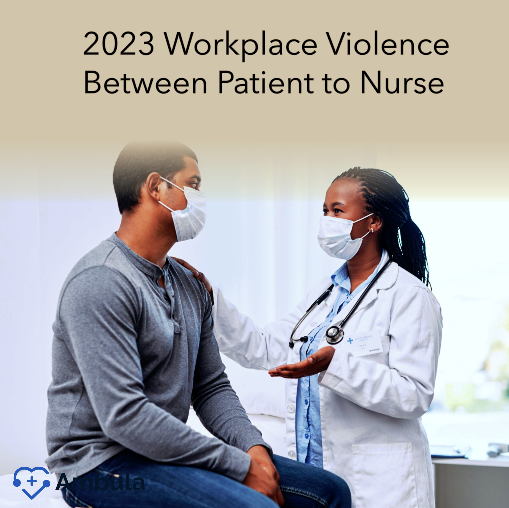
Today, we will tackle a rather serious and often overlooked subject – workplace violence in healthcare, more specifically, between patients and nurses. I know it’s not the most cheerful topic, but please bear with me because this is an important one to discuss, especially given that it’s happening more frequently than many of us realize. I’m not saying all patients give healthcare staff a hard time, but the ones who do create a threatening environment that no one should have to work in.
Workplace violence in the healthcare sector is a complex, multifaceted issue requiring comprehensive solutions. Its consequences range from physical injuries to severe emotional trauma, affecting the quality of care provided. And that’s why our discourse on this topic will hopefully shed more light on what can be done to contain this situation.
We’ll start by knowing what we mean by workplace violence, and then we’ll address what the situation might look like by 2023 if we don’t take immediate action. Throughout our journey, we’ll learn how to deal with complex patients, reflect on patient responsibilities, and explore patient medication rights.
Defining Workplace Violence
So, first things first – what exactly is ‘workplace violence’? It refers to any acts where staff are abused, threatened, or assaulted, both physically and verbally, in circumstances related to their work. This can involve incidents where staff are hurt, threatened with a weapon, sexually harassed, intimidated, or sworn at. The most heartbreaking part? These acts come from the people healthcare workers, including nurses, are trying to help.
If you’re imagining that workplace violence is rare, particularly in hospitals, I regret to inform you that’s not the case. According to a 2018 Occupational Safety and Health Administration (OSHA) review, healthcare and social service workers are almost five times more likely to face violence at work than any other employee.
Workplace violence can lead to severe physical injuries and long-lasting psychological impacts. For nurses who are on the front line of patient care, such occurrences can lead to decreased morale and job satisfaction. They can even deter aspiring nurses from entering the profession. This is not an issue we can afford to sideline any longer.
Current State Of Workplace Violence
From recent surveys, it’s become apparent that many nurses have, unfortunately, experienced some form of violence in their workplace. According to a report from the American Nurses Association, almost 25% of nurses have been physically assaulted by a patient or a patient’s family member while on the job. That’s a worrying statistic, considering how much nurses do for us all, isn’t it?
Despite these alarming numbers, it’s generally believed that these figures underestimate the real extent of the problem. Many incidents stay unreported due to fear of retaliation, the stigma around being a ‘victim,’ or the mistaken belief that violence is ‘part of the job.’ Nurses, like any other workers, have a right to a safe working environment, and it’s about time we all recognized it.
Moving forward, we can’t expect an improvement unless we start addressing this issue with the urgency it requires. Examining trends over the past decade gives us a grim forecast for 2023 – unless things change. Next, let’s explore the reasons behind these trends and understand what we can do about it.
Trends Leading Up to 2023
Given the trends from the past few years, it looks like we’re staring at an uphill battle when it comes to mitigating patient-to-nurse violence by 2023. Increasing patient loads, widespread staff shortages, and the escalating demands of nursing can stir up the perfect storm.
Many nurses’ narratives reveal a pattern of rising aggression and lesser tolerance, often correlating with crowded hospitals and longer waiting times. However, we’re not powerless against these trends. We can change with increased awareness, national campaigns, and swift actions. But first, we must understand what could drive a patient to act violently.
In examining patient behavior, we need to remember that hospitals are not happy places for most. Fear, pain, and confusion can blend, causing patients to lash out. That being said, the underlying reason does not excuse violent behavior. Instead, it should guide our response and prevention strategies.
Potential Causes of Workplace Violence
So, what are the main factors inciting patients to violence? From countless accounts and studies, several crucial elements seem to stand out. Pain, anxiety, long wait times, lack of attention, frustration, psychiatric disorders or cognitive impairment, and even side effects from medications might propel patients to commit acts of violence.
Some patients might misinterpret nurses’ actions, perceive them as threatening, and retaliate. Others may lash out without being fully aware of their actions due to cognitive impairment or a psychiatric disorder. In such cases, addressing the root cause could help significantly reduce patient-to-nurse violence.
Tackling these causes isn’t about justifying violent behavior; it’s about understanding why it happens and finding ways to prevent it. This process often begins with learning how to deal with difficult patients effectively.
Dealing with Difficult Patients
To say dealing with difficult patients is a challenge would be an understatement. But it’s a part of the job, and thankfully, there are strategies available that can be useful. It begins with excellent communication. Explaining to the patient what you’re doing and why and addressing their concerns can alleviate many fears or frustrations that may otherwise escalate to aggression.
Another vital aspect to consider is empathy. Patients are often in vulnerable states. They’re probably scared, anxious, and not on their best behavior. Showing empathy doesn’t mean you have to tolerate violence – it’s about acknowledging their feelings and making them feel seen.
Moreover, setting clear boundaries is crucial. A solid nurse-patient relationship is built on respect. If a patient is becoming overly aggressive, clearly but politely let them know it’s unacceptable. Additionally, having well-established procedures can immensely help nurses deal with difficult situations.
Impact on Nurses
So, what does all this mean for our nurses? Workplace violence impacts nurses physically and psychologically, often beyond visible injuries. Substantive research has indicated that violent encounters could lead to stress, burnout, fear, depression, and even post-traumatic stress disorder.
Nurses have confessed to experiencing difficulties concentrating, anxiety about returning to work, or even considering leaving the profession. Considering the conditions, it’s crucial to remember that such feelings and reactions are completely natural and valid. No one should have to deal with violence at their workplace – and yet, it’s become a disturbing reality that so many nurses face regularly.
We can all agree that happier, healthier nurses mean better patient care. So, addressing workplace violence isn’t just an occupational issue. It could very well be an essential step towards improving healthcare overall.
Nurses’ Testimonials
The personal stories of nurses who’ve experienced patient violence are a testament to the severity and pervasiveness of the issue. Take the case of Lucy, a nurse punched by a confused patient. While she was physically okay, the emotional toll was significant. It showed her the reality of patient-to-nurse violence and highlighted its importance and urgency.
Similarly, another nurse, Mark, recounts being verbally abused so frequently that it became ‘part of the job.’ Regrettably, any nurse should feel that way. Sharing these stories is not meant to scare you or paint healthcare in a bad light. Rather, it’s to shed light on the realities many nurses face, drive change, and ensure that no more nurses have to accept violence as ‘part of the job.’
Evaluating Current Measures
It begs the question, what are we currently doing to deal with this problem? Several measures are implemented to control patient-to-nurse violence, from surveillance systems to violence risk assessments and designated safety officers.
Despite these efforts, we seem to be missing the mark, judging by the increasing rates of violence. These actions alone are not enough. We must address the root causes, improve reporting systems, promote a culture of safety, and ensure accountability.
Recommended Changes for the Future
So, what’s the road ahead? How do we ensure that by 2023, violence in the healthcare sector is not the norm? It commences with altering our perspective, recognizing patient aggression for what it often is – a symptom of a bigger problem, be it untreated pain, poor patient education, or a systemic issue.
Training healthcare staff on preventing and managing violence, setting clear policies, and encouraging incident reporting are suggested improvements. Additionally, there’s a need for more emphasis on patient responsibilities and patient medication rights, ensuring that patients are well-informed about their care.
Conclusion
Even as we conclude, remember that every nurse who has faced workplace violence is someone’s friend, sibling, or parent. They’re individuals with emotions who assume a massive responsibility for our health. Ensuring that they can work in a safe environment should be non-negotiable.
Remember, next time you’re in a healthcare setting, be conscious of how you interact with nurses and other staff. Understanding, respect, and empathy can go a long way in preventing incidents of violence.
I hope today’s conversation sparks the much-needed dialogue around workplace violence in healthcare. After all, by working together, we can stop the 2023 prediction from becoming a reality.




